BY BARBARA T. NELLES
A decade ago, who would’ve guessed that foam and latex suppliers would be using words like “magic” and “sizzle” to describe their offerings?
But they are. Mattress manufacturers seeking to add pizazz to their lineups have embraced all types of specialty foams. Today’s foams are available in beautiful colors, cuts, convolutions and coring with myriad technical attributes—and they sleep cooler than ever before, suppliers say.
Indeed, solving consumer complaints about foam and temperature regulation has been job one. The result is that foam and latex are plumping up and filling out mattresses in higher proportions than ever before.

In the zone Januka Karunasena of natural latex supplier Arpico in Maharagama, Sri Lanka, poses with core cutaways that reduce partner disturbance, improve airflow and create zoned comfort.
Nowhere was the “cool element” that foams bring to beds more evident than in the exhibitors’ stands at Interzum Cologne in Cologne, Germany, in May. At Gommagomma’s booth, the Spine Line was displayed alongside a “steaming” demonstration table for its highly breathable H-Air polyurethane foam. The Caronno Pertusella, Italy-based company’s multicolored engineered cores are contour cut and layered. They can be customized to the needs of individual sleepers.
FoamPartner Group, a division of Fritz Nauer AG with headquarters in Wolfhausen, Switzerland, stopped traffic with its concept beds that use six or seven varieties of vividly colored foams that include rod and sphere shapes.
“It’s all about function, zoning and being visually attractive,” says Rita Kollbrunner, FoamPartner Group head of marketing and communications. “We aren’t just pouring foam. Our customers look to us to help them tell a story to their customers with pictures, marketing materials and a brand.”
Perhaps the most striking display was at Orsa Foam S.p.A., where a forest of Plexiglass columns were filled with colorful engineered cores. The Gorla Minore, Italy-based company launched a resilient and more open-cell polyurethane foam collection at the show.
Back in the United States, BedTimes spoke with Carpenter Co., which says it’s seeing steady growth and potential for its Ergonomic Performance engineered cores.
“Engineered cores got their start in Europe, and we’re seeing strong growth here, especially with ones that work well with articulating (adjustable) bases,” says Bob Steelman, vice president of sales and marketing for the Richmond, Va.-based company. “Engineered cores have lots of eye appeal and offer posturized support through special cuts, contours, layers and coring.”
It’s true, suppliers say. Foams add fascination to beds, giving them a certain glamor on the sales floor.
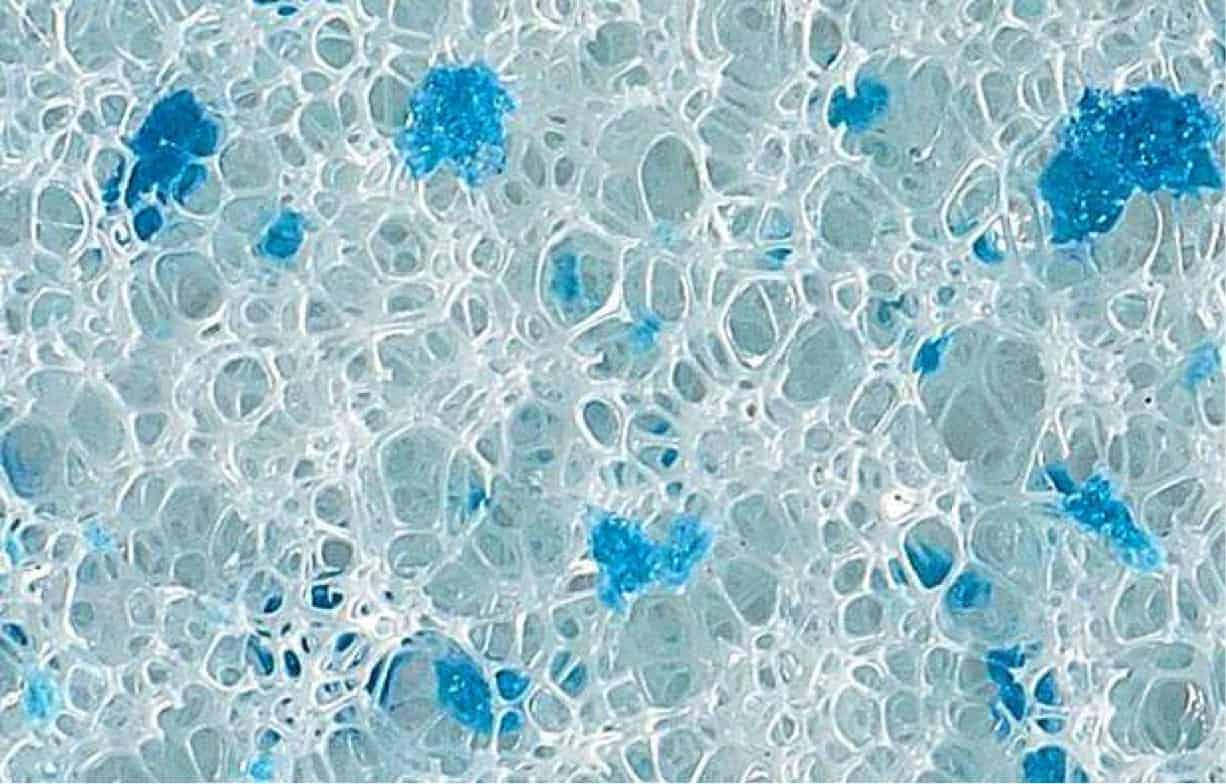
Cool close-up Elite Foam, with headquarters in Newnan, Ga., has formulated a cooler, more breathable visco-elastic foam that is very open cell and infused with microgel particles.
More, more, more!
“We are seeing manufacturers invest in more foams and better quality foams,” says Rick Anthony, director of sales for HSM Bedding Solutions headquartered in Hickory, N.C. “In years past, the 1.2-pound foam was the standard comfort layer in a quilted, traditional mattress. Today, we’re seeing 1.4-pound to 1.8-pound better quality foams and, in specialty bedding, better quality foams from the bottom up. When you’re trying to command higher price points, you’ve got to substantiate it with better quality foams.”
It’s now a given that mattress brands offer one or more all-foam collections, suppliers say. What’s new is the amount of foam being used in beds.
“We did consumer research and found that even if they can’t afford a $4,000 specialty bed, everyone wants a little of ‘the magic that goes on top.’ They’ll buy a hybrid mattress with latex or some other foam on top,” says Kurt Ling, chief executive officer of Pure LatexBLISS, the finished mattress division of supplier Latex International in Shelton, Conn.
According to Nathan Elliott, marketing manager for Indianapolis-based Foamcraft, a 60-year-old foam fabricator with five plants in the Midwest, “The demand for full-foam mattresses continues to build. The typical all-foam bed has multiple layers where each one serves a different purpose. In a typical 12-inch foam mattress, you’ll have five to six layers of foam—and you can even have up to 12. Different layers may be channeled for airflow or have surface modification for softness or zoning.”
Major brands such as Sealy and Simmons have created mattresses that are essentially half foam and half innerspring. The beds have a short foam-encased pocket spring topped with multiple layers of foams.
“We’re definitely enjoying the increase in all-foam bedding and the fact that more foam is being layered in (hybrid) beds,” says Michael Crowell, vice president of marketing for Flexible Foam Products in Spencerville, Ohio.
Today’s latex hybrids use more latex, and all-latex beds have become more common, Ling says.
“Four years ago, mattress manufacturers were using 1 inch or even ¾ inch of latex in a bed and not many were manufacturing all-latex models. And hats off to Mark Quinn (segment vice president of marketing for Carthage, Mo.-based Leggett & Platt Inc.) and the hybrid campaign for raising awareness of the category,” Ling says. “In the coming months, thanks to interest in hybrid beds, you’re going to see more and more major manufacturers introducing 3 and 4 inches of latex in a hybrid bed.”

Totally tubular Latex International, based in Shelton, Conn., is pouring latex in vertical cylinders, as well as horizontal tubes (shown here imbued with graphite for softness and durability) for improved airflow.
Ling continues, “It’s gotten to the point where we have three types of hybrid beds today—innerspring with visco, innerspring with latex, and innerspring with visco and latex. And, in general, a whole lot more producers are making all-latex models compared with five years ago. You’ll see what I mean at the January market in Las Vegas.”
Latex supplier Latexco LLC, with world headquarters in Tielt, Belgium, has expanded its lineup to include specialty polyurethane foams.
“It’s because we’re not just a latex company—we’re a comfort company,” says Vincent Gesquiere, executive vice president and general manager of the company’s Lavonia, Ga.-based U.S. division.
Latexco’s Fõm collection is produced with a “gravity-fed technology” and includes NeuFõm, a nontemperature-sensitive memory foam with fast recovery; AerFõm, a very open-cell memory foam with a traditional feel; EvoFõm, a polyurethane with a lot of bounce; and FloFõm, a memory foam and polyurethane foam hybrid with medium recovery and a “steady feel in temperature.” Fõm products sold in the North American market are manufactured at the company’s Georgia plant.
How cool is that?
Across the board, foamers are determined to vanquish consumer perceptions that foam beds “sleep hot.”
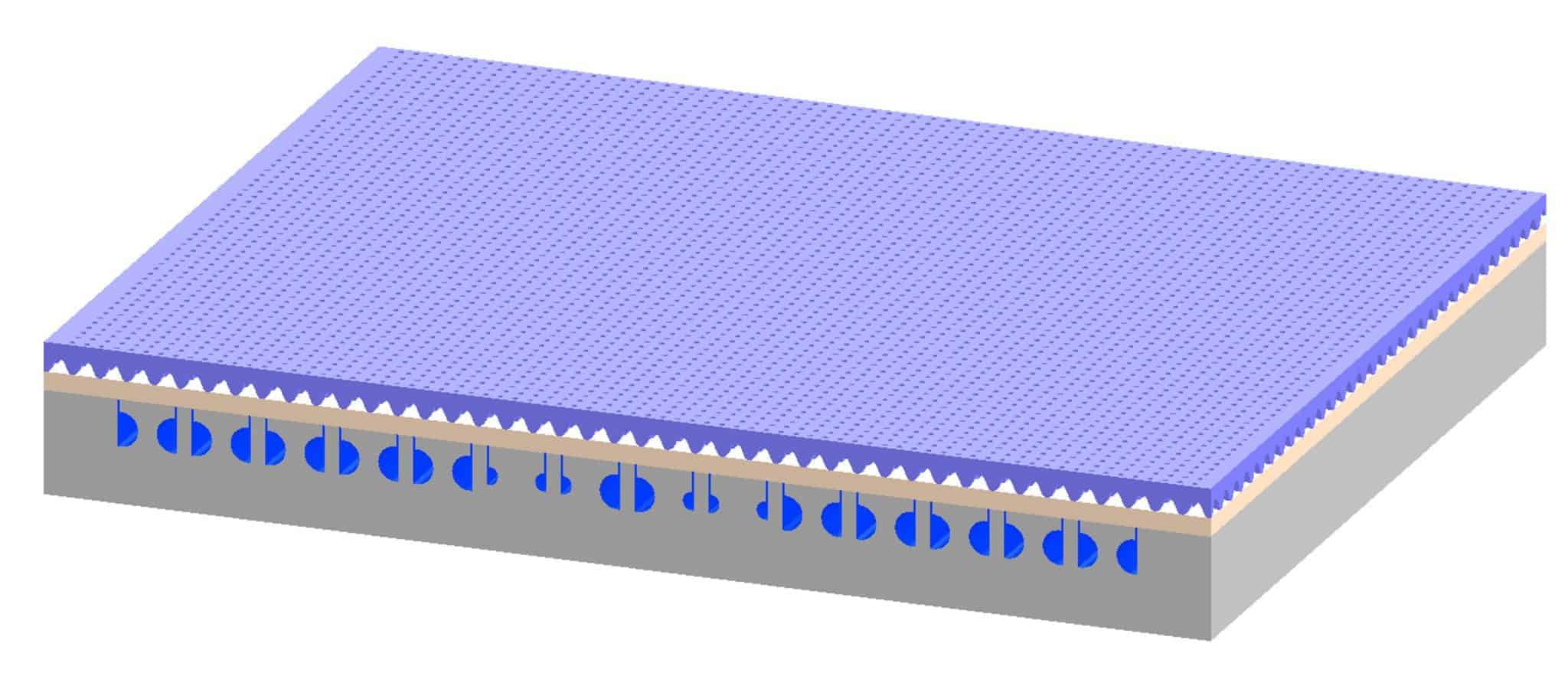
Animated airflow This Ergonomic Performance core from Carpenter Co., headquartered in Richmond, Va., has multiple layers and maximum breathability.
Foam introductions are chemically formulated to have very open cells. They are reticulated. They are perforated, channeled, cut and contoured for improved airflow.
“Very breathable foams are our big story,” says Monica Rossi, export manager for Orsa Foam. “We’ve backed up our claims with laboratory testing.”
At Interzum Cologne, the company introduced Breeze, a line of two polyurethane foams that includes a high-resiliency foam and a visco-elastic foam that are “substantially more breathable.” Breeze visco-elastic foam is highly porous, has a fast response and is nonreactive to temperature changes, according to the company.
Carpenter has the capability to pinhole core any foam or engineered core at all of its plants.
“We’re on the forefront of breathability with our Active Air Technology—it’s one way to mechanically open foam up to allow air circulation,” Steelman says. “Coring also reduces moisture.”
David Wright, vice president of Elite Foam, which pours and fabricates specialty foams and is based in Newnan, Ga., says he sees more interest in surface-modified foams and pinhole coring of all foams to improve ventilation.
“Our main focus in new product development is improving comfort and thermal regulation,” he says. “We’ve created a more open-cell visco that is 10 times more breathable than regular memory foam.”
One of Elite’s newest offerings is Energex, a medium-resiliency foam for the top comfort layers.
“Used by itself or right below a memory foam layer and above the core, it becomes even springier when it warms up, adding resiliency—but without reducing comfort or conformance—which allows you to move around or get out of bed easier,” Wright says.
FXI, headquartered in Media, Pa., introduced Aerus, a very open-cell visco-elastic that is “soft, durable and breathable.” The foam is used in FXI’s Bios line of finished toppers, introduced earlier this year.
Aerus allows five times more airflow and four times faster heat dissipation than traditional memory foam, says Diane Adams, FXI senior vice president and chief marketing officer.
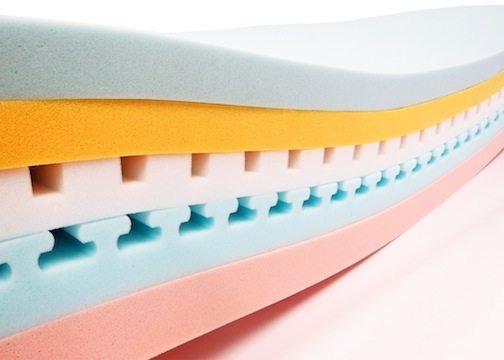
Layered look Indianapolis-based fabricator Foamcraft helps customers create layer-cake looks in all-foam bedding and hybrid bedding.
In Europe, where all-foam mattresses dominate the marketplace, you don’t need to use visco-elastic foam to manufacture a high-end bed, FoamPartner Group’s Kollbrunner says. The company’s newest product—EvoPoreHRC (HRC stands for “High Resilience Climate”)—is a polyurethane foam that is extremely lightweight and durable, in addition to offering excellent airflow and moisture wicking.
According to Flexible Foam’s Crowell, foamers are looking at “new types of foams, new chemistries for more open-cell foams and they’re mechanically opening up—perforating—the foams used in mattresses.
“Because we have more customers buying fully assembled cores, Flexible Foam has invested in boring machines that drill holes all the way through a mattress—not just in individual layers. There can be lateral holes in a bed as well, and coring can be done in zones.”
Netlike reticulated foams are the most porous polyurethane foams and recently have become available as a mattress component.
FXI offers MaxPerm, a reticulated foam available in a variety of firmnesses.
“MaxPerm can be used in different comfort layers of the bed to achieve greater consistency of airflow throughout the mattress,” Adams says. “It is a true post-process reticulated foam that is ‘zapped’ in a thermal reticulation chamber. We’ve refined this reticulated product for the bedding industry to make it durable, long-lasting and resilient.”
HSM introduced “insitu reticulated” Preserve Hi Flo foams earlier this year.
Reticulation is achieved “inline via chemical formulation,” Anthony says. “Our ability to pour the foam in wide widths does away with seams in queen and king beds, which can interrupt the personality of the airflow. And we can do multiple densities and ILDs for quilting and layer construction. You can use Preserve Hi Flo right below the quilt at the top of the bed or beneath a layer of memory foam, creating a channel to wick heat away, right below the first comfort layer.”
Gel vs. phase change—or both
According to European foamers, gel foams haven’t taken off in Europe as they have in other markets. In the United States and Canada, most better foam and hybrid mattresses contain some element of poured gel or gel-infused visco or latex. Some U.S. foamers say that gel has “reached a saturation point”; others say it will continue to be popular at the top of the mattress.

Reticulated display FXI, based in Media, Pa., has created netlike MaxPerm, a ‘post-process’ reticulated polyurethane foam designed to increase airflow in comfort layers.
“Gel foams like our Preserve VG have been on the market long enough that they have become a standard,” Anthony says. “We have always offered the gel-infused visco-elastic—not the beads—as we feel it’s more consistent.”
FXI is launching an entire collection of gel foams this fall called MemGel. An initial MemGel offering, a swirled gel, is out now and also is used in the company’s Bios Sleep System finished toppers. The new collection will focus on support and pressure relief, not temperature management, Adams says.
Rossi at Orsa Foam says that “while gel products are good for pressure relief, in Europe you will find they are not as popular as in the United States. For temperature regulation, we prefer foams with phase-change material.”
Orsa’s I-Foam Thermo collection of polyurethane foams has “microspheres” of phase-change material that “absorb heat from the sleeper” and “give back heat” when needed to maintain a constant temperature.
“Gel foam is trending in Europe, but we consider the cooling properties unproven,” says Dennes Need, sales manager of Draka Interfoam, a division of the Vita Group based in Hillegom, Netherlands. Vita offers “marbleized” GF5758 gel foam for bedding.
“We do know that gel has orthopedic properties; it’s proven to add comfort and pressure relief and that it is more resilient,” Need says.
The use of phase-change material in foams is growing in the United States, too.
Latex International’s Talalay GL has gel capsules containing PCM and was brought to market in 2012. The product has been extremely successful, according to the company.
“This type of layer, with both gel and phase change is becoming the new norm for the top of the bed,” Ling says.
Elite Foam, which offers memory foam with microgel beads that “absorb and liberate heat,” according to Wright, has introduced an encapsulated phase-change material into the beads. Therma Phase Gel is a “phase-change microgel that should be used as close to the surface of the bed as possible.”
In 2012, Carpenter began offering Outlast phase- change technology with any visco-elastic or conventional foam.
“We’ve found that phase-change material can make ticking stiff, so we adhere it to the top of the foam,” Steelman says. “Also, when you concentrate the phase change on the surface, it’s more effective than mixing it into a foam.”
Latex foam rules, rewritten
Mattress manufacturers are mixing and mingling latex in high-end mattresses that may have memory foam, gel or other comfort materials—not to mention microcoils—in the upholstery layers. Whereas suppliers once advised manufacturers to layer the latex at the very top of the bed, preferably beneath an unquilted panel, the new rule is: “If it feels good, do it.”
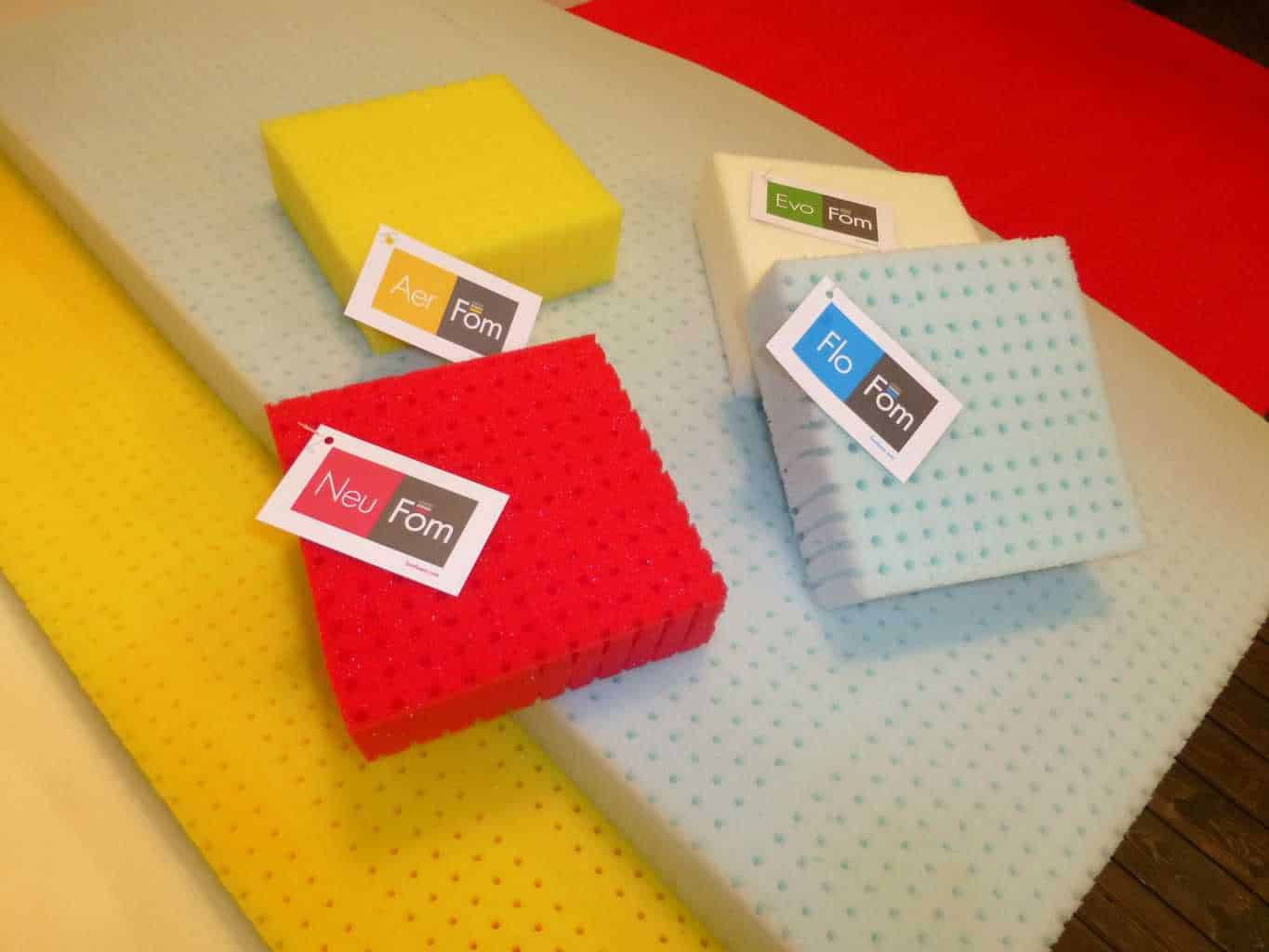
New direction Tielt, Belgium-based latex supplier Latexco LLC has launched the Fõm collection—four specialty polyurethane and memory foams.
Latex suppliers have loosened the rules, mixing in new additives and giving latex many new comfort properties and poured profiles.
While latex is naturally breathable, Ling says, Pure LatexBLISS has taken it a step further and offers new tube and cylinder contours.
“We also recently introduced latex with graphite, which creates a stronger, more durable product that also is softer and more flexible—perfect for the top layers of a mattress,” Ling says. “We’re working with BASF right now on what we can mix in next.”
Natural latex supplier Arpico, a division of Richard Pieris Natural Foams Ltd. in Maharagama, Sri Lanka, has greatly expanded its European distribution, says Januka Karunasena, general manager, and is focused on pouring latex for mattresses in a variety of profiles that reduce partner disturbance, improve airflow throughout the bed and create zoned comfort.
Arpico’s all-natural latex is certified to the Global Organic Latex Standard.
In 2012, Latexco introduced a third latex pouring technology. The SonoCore process uses radio-wave frequency instead of conventional heating and drying to create latex foam rubber.
“The mixture is given ‘a shock’ that immediately turns it from liquid to solid, and this creates a more even texture and structure,” says Alexander Bolliou, chief executive officer of Latexco. “It is strong, very open cell and with good ventilation and good moisture and temperature control.”
Latexco unveiled two topper foams at Interzum using SonoCore technology. Pulse is an extremely strong latex with “superior ventilation properties.” Reshape is a slow-recovery latex that is “shape conforming” without being affected by room or body temperature.
New angles on foam sustainability
In foam production, most of the sustainability discussion has shifted to manufacturing practices and product life cycle. Manufacturers and the public, however, continue to be “interested in what’s in the foam and what’s in their bed,” Crowell says.

Really ‘green’ Cees Zielman, general manager of Vita Talalay, a division of the Vita Group based in Maastricht, Netherlands, holds the company’s 100% natural Talalay latex, which has obtained Cradle to Cradle certification from the Environmental Protection Encouragement Agency.
U.S.-based foamers mentioned the importance of CertiPUR-US, a foam certification process that ensures product quality, durability and safety, as well as sustainable manufacturing practices and indoor emission reduction. (It’s based on a similar certification in Europe.)
“We concentrate on reducing our carbon footprint through clean, environmentally sound manufacturing processes,” Carpenter’s Steelman says.
The use of bio-based content continues to be a strong part of HSM’s foam strategy.
“We routinely use a percentage of bio-based content in a majority of our products,” Anthony says. “It’s a sustainable practice that also adds stability to our production costs.”
Latexco emphasizes a four-fold commitment to sustainability. Its products have a high percentage of natural latex, which is derived from a renewable resource. It set up a latex recycling company that reuses more than 4,000 tons annually of post-industrial waste from its own and customers’ manufacturing processes. Latexco recycles and reuses 95% of all process water and the company has reduced its energy consumption by 50% in eight years.
“Latex is very energy consuming to produce, but we have significantly reduced CO2 emissions in production,” Latexco’s Bolliou says. “We have fine-tuned the latex compound mixture we use to reduce washing, produce our own electricity, recycle our water and more. We’re proud to be a sustainable producer of latex.”
Vita Talalay, a division of the Vita Group based in Maastricht, Netherlands, announced at Interzum Cologne that it has achieved Cradle to Cradle certification for its 100% natural Talalay product, from the Environmental Protection Encouragement Agency in Hamburg, Germany.
“This is important to customers who manufacture a natural bed,” says Cees Zielman, Vita Talalay general manager. “The Cradle to Cradle system certifies everything. The end goal is that the mattress would come back at the end of its useful life, and our company can move it up into a new product. We have a separate company that is transforming used latex foam rubber into new solid rubber applications—not grinding or cutting it up. This can only be done if you have a pure latex product to begin with.

Flow-through foam Preserve Hi Flo foam from Hickory, N.C.-based HSM allows heat and moisture to wick away from sleepers.
“We believe that if you are capable of producing a sustainable product, you have an obligation to do so. We reformulated the natural Talalay to ensure it is very pure and all of the proteins are removed so people don’t react to them. We anticipate the product will have a major appeal in the U.S., especially on the West Coast, and in Scandinavia, Germany and Holland, where it is already being picked up rapidly.”
Chaminda Serasinha is a consultant, author and inventor associated with Nippon Nature Foams, Shigadry With Earth Co. Japan and Carbon Negative Products Co. He believes that use of latex by the bedding industry can actually help mitigate the effects of climate change. Roughly 36 billion tons of greenhouse gases are emitted into the Earth’s atmosphere every year, Serasinha says.
“The Earth’s natural systems cannot absorb all this back and a good portion remains in the atmosphere, interfering with our climate,” he says. “Simply put, the rubber tree is among the top natural C02 absorbers and its yield, latex, is predominantly made of carbon—carbon absorbed from the atmosphere. When you make a natural latex mattress, you promote the growth of rubber trees. When you assess the amount of C02 that rubber trees have absorbed to create latex for a mattress and set it against all the greenhouse gas emissions released during the manufacture of that mattress, it’s negative—the whole process of manufacturing, procuring and using this mattress creates a reversal of atmospheric pollution. (This equation is based on the testing of unique formulas we have derived, published data on carbon sequestration of rubber trees, and a comprehensive assessment of greenhouse gas inventory under ISO 14064 standards at our factories.)
“The model not only helps to mitigate climate change, it also is sustainable, promotes biodiversity and conforms to a ‘green’ business model. A small increase in the market share of natural latex bedding can promote the growth of thousands of hectares of lush rubber plantations absorbing tons of C02 from the atmosphere.”
More sizzle coming soon
Foamers have a slew of new products in the pipeline and hint at more introductions blending latex, visco-elastic and traditional foams.
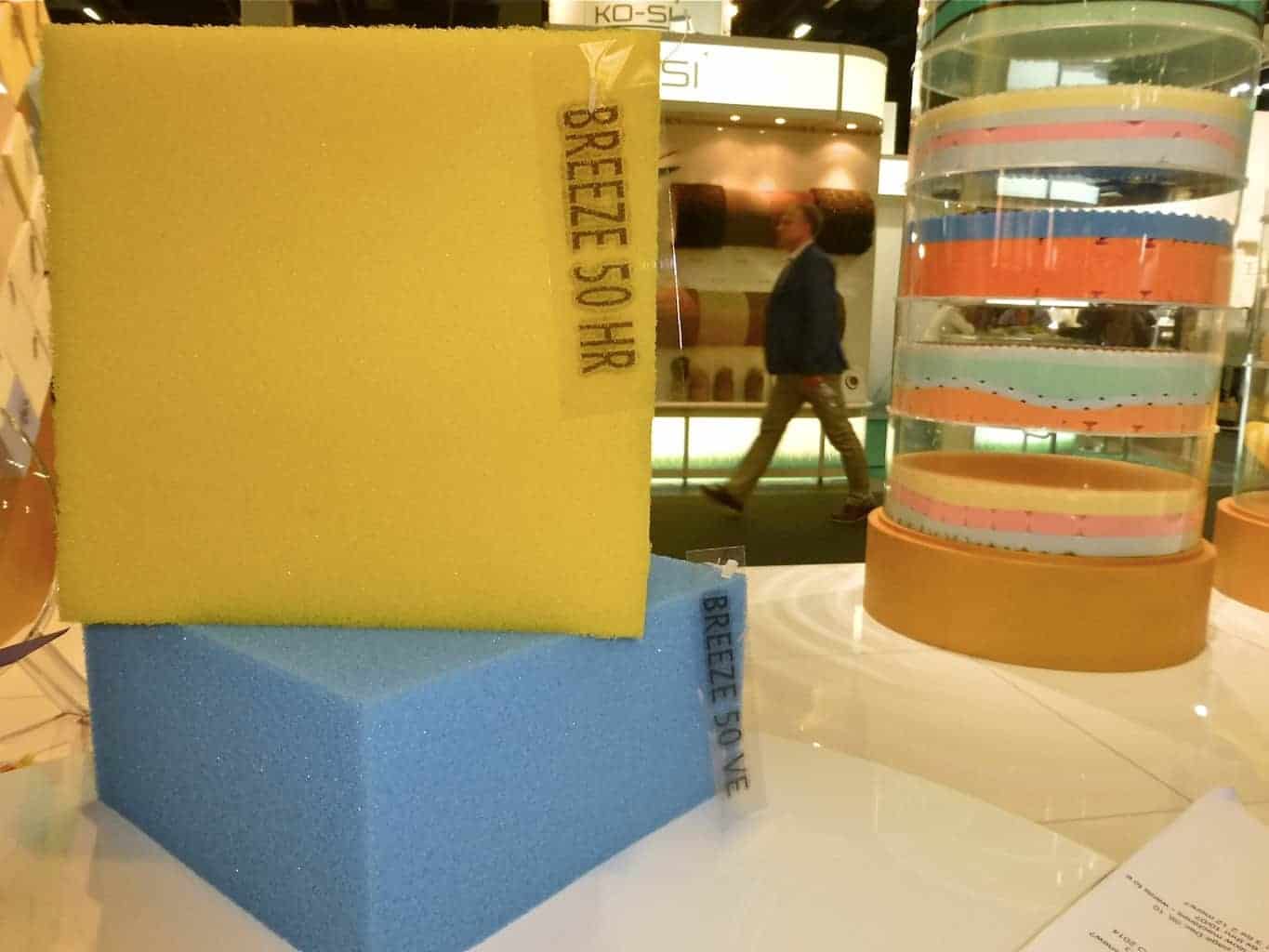
Proven porosity Orsa Foam S.p.A., with headquarters in Gorla Minore, Italy, introduced highly breathable Breeze foams—a high-resiliencypolyurethane foam and a fast-response visco-elastic—at Interzum Cologne.
Flexible Foam is exploring a range of additives that will join its G Flex gel foams and Micronal PCM technology (from BASF).
“There are all types of substances that can be mixed into foams—many are still in their infancy,” Crowell says.
Kollbrunner says FoamPartner will continue to innovate as European bed makers look for distinctive foams and accompanying point-of-sale materials to help build their brands.
As technicians at FXI’s Research and Innovation Center in Aston, Pa., put the finishing touches on the portfolio of MemGel foams launching this fall, Adams says, “these foams will add even more sizzle to beds—the focus will be on pressure relief, cushioning and support.”
Steelman adds, “We have a special team of innovators and have added an innovation division to our research and development department. Look for more news from us soon because we’re always on the hunt for the next best thing in foam technology.”
FIND FOAM SUPPLIERS
To find suppliers of a variety of bedding foams, check out the BedTimes Supplies Guide. The guide also is published annually in the December issue of BedTimes.




